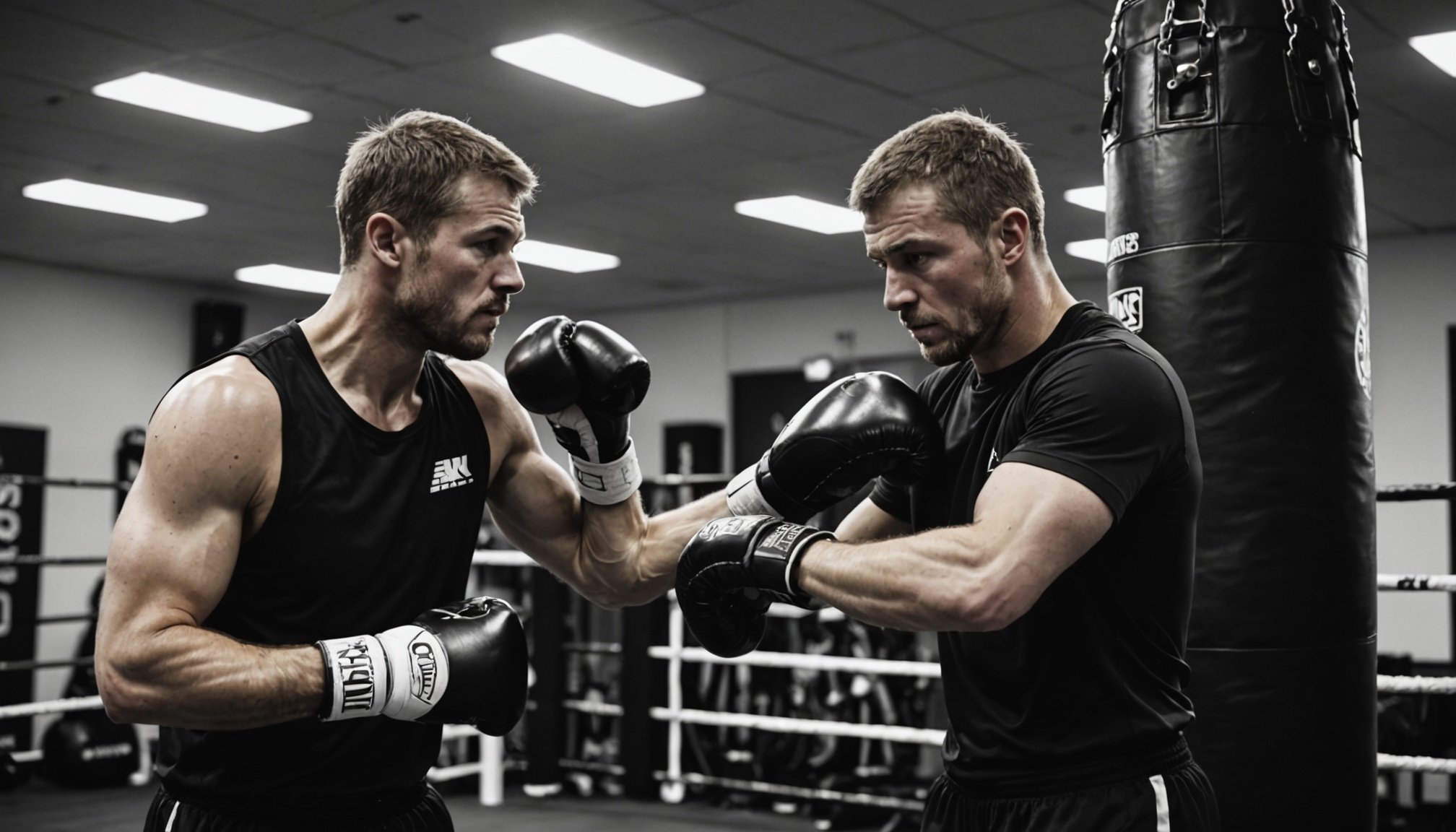Unlocking Success: How UK Boxing Coaches Strategically Employ Periodization for Effective Training Cycles
Understanding Periodization in Boxing
Periodization is a training methodology that has been a cornerstone of athletic development across various sports, including boxing. This approach involves dividing the training year into specific periods or cycles, each with distinct goals and intensities. For UK boxing coaches, periodization is not just a strategy; it is a science that helps athletes achieve peak performance.
Macrocycles and Training Phases
A typical periodization plan in boxing is structured around macrocycles, which are annual training plans divided into several mesocycles (monthly or quarterly cycles) and microcycles (weekly cycles). Each phase has a specific focus, such as the general preparatory period, specific preparatory period, competitive period, and recovery period[4].
This might interest you : Top Footwork Drills for UK Wrestlers to Master Mat Control and Elevate Performance
- General Preparatory Period: This phase focuses on building overall fitness, strength, and endurance. Coaches incorporate high-intensity full-body exercises, strength training, and cardiovascular conditioning to lay the foundation for the upcoming competitive season.
- Specific Preparatory Period: Here, the training becomes more specialized, focusing on the specific demands of boxing. Coaches introduce sparring sessions, technical drills, and strength exercises tailored to improve punching power, speed, and agility.
- Competitive Period: During this phase, the training intensity peaks, and the focus shifts to fine-tuning skills and strategies for upcoming fights. Coaches often reduce the volume of training while maintaining high intensity to ensure athletes are at their best for competitions.
- Recovery Period: After the competitive season, athletes enter a recovery phase where the training intensity is significantly reduced. This period is crucial for allowing the body to recover and rebuild, preventing overtraining and injuries.
Tailoring Training to Meet Specific Demands
Boxing is a multifaceted sport that requires a blend of strength, speed, power, endurance, and technical skill. UK boxing coaches must tailor their training programs to address these various demands.
Strength Training
Strength is a critical component of boxing, particularly in the upper and lower body. Coaches use a variety of strength training exercises to enhance muscle mass and power.
Also to see : Essential Conditioning Strategies for UK Fencers to Excel Throughout Prolonged Tournaments
- Upper Body Strength: Exercises like the bench press, pull-ups, and dumbbell rows are essential for building the strength needed for powerful punches.
- Lower Body Strength: Squats, deadlifts, and lunges are crucial for stability, balance, and the generation of force from the legs.
- Core Strength: Core training, including planks, Russian twists, and leg raises, is vital for maintaining good posture and generating rotational power during punches.
| Training Phase | Upper Body Strength | Lower Body Strength | Core Strength |
|
|----------------------|
|--------------|
| General Prep | Bench Press (3 sets of 8 reps) | Squats (3 sets of 8 reps) | Planks (3 sets of 60 seconds) |
| Specific Prep | Pull-ups (3 sets of as many reps as possible) | Deadlifts (3 sets of 5 reps) | Russian Twists (3 sets of 15 reps) |
| Competitive | Dumbbell Rows (3 sets of 10 reps) | Lunges (3 sets of 10 reps per leg) | Leg Raises (3 sets of 15 reps) |
Speed and Power Training
Speed and power are equally important in boxing, as they determine an athlete’s ability to land quick and effective punches.
- Speed Training: Coaches use drills such as shadowboxing, bag work, and sparring with a focus on quick combinations to improve hand speed.
- Power Training: Exercises like medicine ball throws and resistance band training are used to enhance punching power. For example, a coach might have an athlete perform three sets of eight medicine ball throws with 10% of their 5RM bench press to improve explosive power[2].
Endurance and Conditioning
Endurance is crucial for boxers to maintain their performance over the duration of a fight. Coaches incorporate various conditioning exercises to improve cardiovascular fitness and muscular endurance.
- High-Intensity Interval Training (HIIT): This involves short bursts of high-intensity exercise followed by brief periods of rest. For example, a coach might have an athlete perform sprints or burpees for 30 seconds followed by 30 seconds of rest.
- Functional Movement Training: This includes exercises that mimic the movements used in boxing, such as agility drills and plyometric exercises. These help improve overall fitness and reduce the risk of injury.
Practical Insights and Actionable Advice
For UK boxing coaches, the key to successful periodization lies in careful planning, flexibility, and continuous monitoring of the athlete’s progress.
Monitoring Progress
Coaches must regularly assess athletes’ performance through various metrics such as heart rate, muscle strength, and technical skill. This helps in adjusting the training program to meet the specific needs of each athlete.
- **Heart Rate Monitoring**: Tracking heart rate during training sessions can help coaches ensure that athletes are working within the optimal intensity zones.
- **Strength Testing**: Regular strength tests help coaches assess muscle strength and power, allowing them to adjust the training program accordingly.
- **Technical Drills**: Coaches use technical drills to evaluate athletes' technique and make necessary adjustments to improve performance.
Adjusting Training Based on Feedback
Feedback from athletes and data from monitoring tools are crucial for making adjustments to the training program.
- Athlete Feedback: Coaches should regularly seek feedback from athletes regarding their fatigue levels, muscle soreness, and overall feeling. This helps in identifying potential issues early and making necessary adjustments.
- Data Analysis: Analyzing data from heart rate monitors, strength tests, and other metrics helps coaches identify trends and areas for improvement.
Innovative Training Methods
UK boxing coaches are also exploring innovative training methods to gain a competitive edge.
Speleotherapy
Speleotherapy, or training in caves or underground environments, has been investigated for its potential therapeutic benefits. This type of training involves exposure to unique environmental conditions such as low relative humidity, increased negative ions, and specific bacterial flora. While more research is needed, initial findings suggest that speleotherapy could enhance performance parameters in boxers, particularly in terms of strength and endurance[2].
Quotes from Experts
- “Periodization is not just about dividing the training year into phases; it’s about creating a structured plan that addresses the specific needs of each athlete at different times of the year.” – Dr. Emma Ross, Sports Scientist
- “In boxing, it’s not just about being strong or fast; it’s about being strong and fast at the right times. Periodization helps us achieve that balance.” – Joe Smith, UK Boxing Coach
Periodization is a powerful tool in the arsenal of UK boxing coaches, allowing them to tailor training programs that meet the unique demands of the sport. By understanding the different phases of training, incorporating a variety of exercises, and continuously monitoring and adjusting the program, coaches can help athletes achieve peak performance. Whether through traditional strength training, innovative methods like speleotherapy, or careful monitoring and feedback, periodization is the key to unlocking success in the world of boxing.






